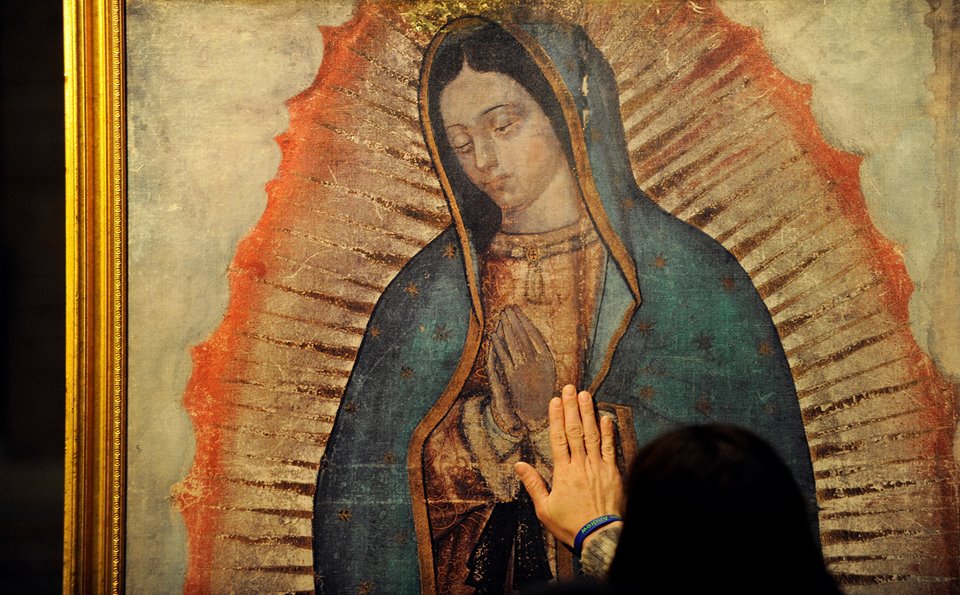New singular discovery on the Guadalupe tilma
There are not only the incredible healings of Lourdes or the great mystery of the image of the Holy Shroud, still inaccessible today to the most powerful excimer lasers of the Enea laboratories of Frascati.
In the Catholic universe (and only in it) there are many other mysteries, many other great challenges for science and faith (remember that the Catholic Church says that no miracle is necessary for the faith of the believer, it can be, if anything, help but never the "reason" why one is a believer), and one of these is certainly the image of Our Lady of Guadalupe impressed on the cloak (also called "Tilma") which belonged to Juan Diego Cuauhtlatoatzin, following the apparition that took place in Mexico in 1531. The cloak of Juan Diego is preserved in the sanctuary that was built, on which the image of Mary appeared, portrayed as a dark-skinned young woman (she is called by the faithful Virgen morenita).
The image does not show any trace of dyes of vegetable, mineral or animal origin, as noted in 1936 by the Nobel prize for chemistry Richard Kuhn and the figure of Mary is directly impressed on the fabric fibers (there are small painted parts, such as "retouching ”, Made later), as determined by the infrared photos of the University of Florida biophysicist, Philip Serna Callahan in 1979, who said that the image is not scientifically possible to be made by man. In 1977 the Peruvian engineer José Aste Tonsmann analyzed the photographs on a computer enlarged 2500 times and found that another drawing appears in Maria's pupils, or a sort of photograph of the moment when Juan Diego showed the cloak to Bishop Juan de Zumárraga , in the presence of two other men and a woman. The eyes of the Virgin on the mantle would therefore behave like human eyes, which reflect what they see through an effect known as Purkin-Sampson's images, and would have "photographed" the scene with a slight rotation of difference between the two eyes, as is normally the case due to the different angle of the light that reaches the pupils. At the center of them we would also see another scene, smaller, also this with different characters.
Another highly mysterious aspect is the duration and the conservation of the fabric: the maguey fiber that constitutes the canvas of the image, in fact, cannot last more than 20 or 30 years. Several centuries ago a replica of the image was painted on a similar maguey fiber cloth, and it disintegrated after a few decades. While, almost 500 years after the alleged miracle, the image of Mary continues to be perfect as the first day. In 1921 Luciano Pèrez, an attacker sent by the government, hid a bomb in a bouquet of flowers placed at the foot of the altar; the explosion damaged the basilica, but the cloak and the glass that protected it remained intact. Finally, the arrangement of the stars on the mantle would not be random but would reflect those that in the sky, from Mexico City, it was possible to see the night of December 9, 1531
A surprising mathematical-scientific discovery has instead been made recently: from the superposition of the stars and flowers on the image, once brought back on the staff, a perfect harmony will emerge (here the melody that has emerged). The discovery was presented during a conference at the San Pio X auditorium in the Vatican.
During the International Workshop on the Scientific approach to Acheiropoietos Images held at ENEA Frascati in 2010, JC Espriella of the Centro Mexicano de Sindonología described the phenomenon, also focusing on the scientific studies carried out and thus concluding: «the image present on the Tilma of Guadalupe is addressed to be an acheropite image, because according to the vast majority of researchers who have studied it with a rigorous scientific method, its origin goes beyond the natural explanation and so far, no satisfactory explanation has been formulated ".
